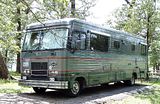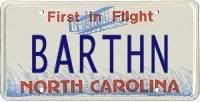Go to...  | Start A New Topic  | Search  | Notify  | Tools  | Reply To This Topic  |  |
| First Month Member |
AH, now I see. Yes, the two shunt thing would be good, but the remote shunt ammeters I have looked at seemed expensive. I like remote shunt ammeters in almost all applications to avoid running heavy wiring, but have not found any at a reasonable price. Hmmmmmmmmmmm........maybe I could disassemble one and use the shunt in a remote location. The main reason I don't like isolators is the .7 volt drop. A Schottky would be less, but why bother. The virtue of an isolator is no moving parts and pretty good reliability. One of my SOBs used a relay that closed to parallel the batteries whenever the ignition was on. It was simple and trouble-free. It had a switch that used the coach batteries to close it if the chassis batt was dead. | |||
|
Captain Doom |
I like the switch-to-house-batteries if the chassis battery is dead thingy. My alternator failed (deep in Nothing Alley in Kentucky at 1 AM). The generator would charge the chassis battery, but only very slowly, and not enough to run with all the lights on. So I had to pull over for an hour, let the generator do its thing, etc. I've since replaced the wimpy 15A converter with a 60A...and carry a robust battery charger. | |||
|
| First Month Member |
Yeah, we had a similar. Now we have an Iota DLS-75-IQ. It is both a converter and a robust battery charger. | |||
|
"5+ Years of Active Membership"  |
Last year while I was reworking my battery tray to hold four golf car batteries, I had the starting battery removed and not connected to the starting system. I decided to try out the ‘aux’ starting system relay/switch, and started the coach successfully from the ‘aux’ mode. That’s the good news, the bad news was, after the engine was running, I released the ‘aux’ switch, and promptly blew out the alternator. Part of the RV experience, and expensive also.  Bill, I have been trying to decide how to handle the boondocking issue of using the generator a minimum amount of time, to recharge the house batteries when the solar system is not providing enough power. I wanted a high output charger, but was looking at the Prosine 2000 as a way to give me inverter power, and a high output charging device. I presently use small inverters and am quite happy with their performance, in that I use some of them all the time similar to a UPS system. (Computer and Satellite system) Your mention of the Iota DLS-75-IQ, caught my attention. I have to assume that you feel that this is the best way to go. After using them, do you still think so, or would you have rather installed a device like the Prosine device. Did you get the unit with the automatic charging control with the jumper to force into a fast charge when using the generator? Thanks in advance for any further discussion on this issue. Maybe this is drifting, and should be a new topic, you choose. ------------------ 89 Barth Regal 32 Runs like a Deere New Hampshire [This message has been edited by Jack (edited October 26, 2005).] | |||
|
| First Month Member |
Oh, heck, we are in terminal thread drift here, anyway. Jack, I can't speak too much to inverters, as we don't use one. As far as minimal genset use while boondocking, we let the solar do its thing, which usually works. However, we do use a toaster oven and blender fairly often, both of which require a generator. So, the genset does its part whenever it gets a chance. Our two golf cart batteries rarely get below 50% overnight, and the solar usually take them up again. It we are parked for several days, I will tilt and aim the panels, especially in winter, when days are shorter and the sun is lower. If the batts need generator charging, the Iota usually kicks in around 40 amps. This may seem like a lot for a 225 amo battery bank, but during the bulk portion of the charging I do not believe it is. I favor battery temperature monitoring over absolute current figures. Some will say 10% is max, some quote 13%, and some say 25%. my 40 amps is under 20%, so I feel OK. I charge until my Trimetric reads about 80% or less, depending on how I predict the solar input that day. Over the years I have found that discharging to 50% and charging to 80% is the most efficient use of generator fuel and noise. Charging above the bulk phase is less efficient, as the current falls off as charging increases, causing you to burn the same fuel for fewer amps. And discharging below 50% shortens battery life. However, I know folks who discharge down to 25 or 35% and still get decent battery life, so my 50% is not a hard figure. It would be fun to run tests and eliminate variables, but not practical. When I worked, we had a bunch of golf carts, and I tried to institute some local testing procedures, but I could not get all operators on board and was unable to monitor the usage and testing myself at a 24/7 operation, so I could not come up with hard figures, just theories formed from observation. The corporate suits seemed not to care, even though the company has hundreds of golf carts and other battery powered equipment and thousands of batteries in use. Now, with four GC batts in your rig, you might not be at 50% in the morning. I would suggest that you not run the genset until you are down to 50%, just to save fuel. Some would suggest that you not charge at all (even solar) until you are below 80%, as short cycling will also lead to stratification and sulfation. My own feelings are that if you do not get down to 80%, you have more batteries than you need and should consider downsizing on the next purchase. Battery bank size is always a balance of usage, cost and space. However, if you use your furnace in winter, that will require a larger battery bank than a user who does not use the furnace. Actually, my purchase of the Iota was partially influenced by getting a real good price on a used one from a friend who went to a combined converter/charger/inverter. But, yes, I would probably buy it again. I think I would also look at one made in Canada, too. I can't remember the name, but a couple of guys whose opinion I respect chose it. In the spirit of minimal genset use that you mention, I should add that if we are around others and need to run the genset to charge, I wait until someone else fires theirs up before I run mine. That way, I feel less guilty about the noise. | |||
|
Captain Doom |
The converter I installed is the Single Output RV 60 Amp Intelli-Power w/ Charge Wizard, just for general info here. Single output converters keep the battery charged while it runs the house 12V circuits. Dual output converters have a relay, and power the house or charge the batteries. The Charge wizard periodically runs a desulfating cycle, as well as monitoring charge rate and not overcharging. | |||
|
 3/23 3/23 |
My sob is a 1968 35 Chris Craft Commander and shortly after purchasing it I added a Freedom 10 inverter/charger. The primary reason was to run the 110 fridge without needing the genny. I also liked the idea of 3 stage charging. Were I to do it now I would opt for the Prosine 2000. This will allow use of the typical 1500 watt microwave. The inverter switches such that the microwave clock doesn't know when we go from off to shorepower. We have 5 batteries on board, two start/house on starboard, two house and one start on port. The stbd bank goes to a port/stbd/all switch and the port goes to a start/house/all switch. These are standard make before break battery bank switches. A strange thing happened on the way to making everything work. I had to split the ac wiring to one outlet and the hardwired fridge to get the genny to work. It is a 6.5Kohler with the demand start system. It comes on with a load but has to have a minimum 60 watt to start and run. The inverter was keeping it from seeing the load until I rewired the inverter load. Tim The Prosine should preclude the noise we get on the tv or stereo using the mod square wave of the Freedom. I have 5 batteries on board and control them with the standard | |||
|
Captain Doom |
I get to enjoy the use of the emergency generator at the house - I hooked up line-conditioning UPSs to the PCs and the TVs, and they cleaned up the hash. I don't know if that would smooth out the modified square-wave, though. | |||
|
| First Month Member |
Jim--Any progress? | |||
|
 6/12 6/12Formally known as "Humbojb"  |
Bill--had to leave the Barth at the kids in Tennessee last week and get back to work. The airplane mechanic/jet pilot son-in-law also had to go back to work, so we didn't get past the diagnosis stage. The SIL is talking about using a single wire alternator. He's used them on his drag cars and rock crawlers for quite a while. Instead of a circuit through the fuse block and ignition key, there's just one wire that goes from the alternator to the battery. Ever heard of that kind of set up? I hope to get back up there in two weeks so I can rescue the Barth before winter sets in. Jim | |||
|
| First Month Member |
Yes, and they are good. I use one in my boat, but not my Barth. If an alternator fails, I want to get a replacement quickly and easily. So I stay stock. The one wire alternators have an internal self-energizing regulator, but you could convert a stock alternator to one wire by an external conversion kit. Transpo has them. | |||
|
 6/12 6/12Formally known as "Humbojb"  |
Got a call from the son-in-law in Tennessee today. The alternator that we think is bad is 78amp,remanufactured by Aerostar, part # 41253. He thinks we shoud get at least a 100 amp, probably 120. #8 wire coming off the back of the existing alternator. It's a 1985 28' Regal, normal appliances, radio, tv, etc plus the gear vendors od. What whould you guys and gals suggest? Jim ------------------  | |||
|
Captain Doom |
You probably should replace the #8 wire (rated generally at 40 A) with #4. It would be a good idea to have the wire terminals crimped by an electric shop, as anything over #8 is difficult to do without a very large crimping tool. | |||
|
| First Month Member |
I'd stay stock. I have never seen the advantage of a large alternator. Just more money and trouble at replacement time. Unless you are running an awful lot of equipment while driving, the alternator doesn't have much to do. All the alternator has to do is power whatever is drawing, and recharge the starting battery. Charging the chassis batteries from the alternator has always been frustrating for me. Better to have a proper charger and run the genset. Boat stores sell proper selector switches for deciding which battery the alternator charges. It must make before break or the alternator will blow its regulator and maybe the diode trio. I have been chugging along for years on a 65 or 75 or whatever amp alternator. The most work my alternator ever has to do is run the crock pot so we have dinner ready when we get there. | |||
|
 6/12 6/12Formally known as "Humbojb"  |
Bill, Being electrically "challenged", does the alternator charge both the chasis and coach batteries while the engine is running? There's no switch that I know of that tells the alternator what to do. All I know is that the # 8 wire goes to someplace where the coach and chasis battery cables come together. I haven't looked at it--just listened to what the son-in-law said. Jim | |||
|
| Powered by Social Strata | Page 1 2 3 4 |
| Please Wait. Your request is being processed... |
|
This website is dedicated to the Barth Custom Coach, their owners and those who admire this American made, quality crafted, motor coach.
We are committed to the history, preservation and restoration of the Barth Custom Coach.
We are committed to the history, preservation and restoration of the Barth Custom Coach.

